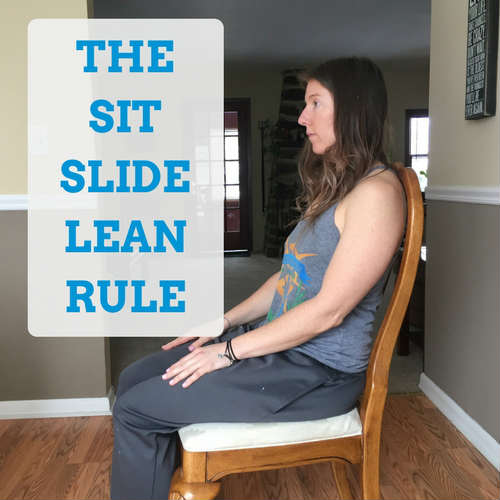
10 Mar Sitting Correctly: The Sit, Slide, Lean Rule
Do we really need to talk about sitting correctly?
Does the …
- type of chair you put your butt on,
- what the back of the chair looks like, or
- if you use a chair back at all …
… really worth reading a blog post about?
Turns out, how you sit is a gigantic deal.
If you have neck or back pain, sitting correctly can be the difference between daily, excruciating pain that grows as the sun sets and calm, mild pain that you can deal with for the rest of your life.
If you don’t have neck or back pain and you want to keep it that way, saving your spine and discs from excessive sitting stresses means pain-free living into your 50’s, 60’s, and 70’s when most older adults you know are struggling with pain they can’t get rid of.
Go ahead right now and take inventory of how many people you know have annoying enough low back pain that they feel the need to share their pain with you.
Take 30 seconds.
I’ll wait.
…
Neck and back pain ain’t going out of style any time soon.
Sitting correctly can help sway the scales towards less pain.
There’s one simple rule that will determine which path you and your body walk down when it comes to sitting.
The Sit, Slide, and Lean Rule for Sitting Correctly
Sit, slide, lean.
Say it with me.
Sit, slide, lean.
The Sit, Slide, and Lean Rule for sitting correctly minimizes load (I define load below) on your spine. For now, think of load as water coming out of a water faucet.
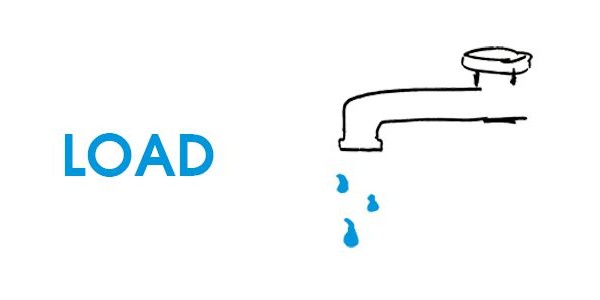
Remember, all pain is caused by load exceeding capacity.
- Load = the work you do. It’s like putting water in your bucket.
- Capacity = the work you’re able to do. It’s the size of your bucket.
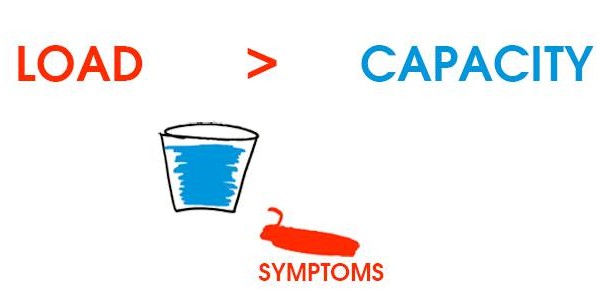
When you are sitting correctly, it’s like you’ve set the faucet dripping into your low back and neck buckets to a trickle.
Sitting poorly, with:
- your back even 1 mm away from the back of the chair…
- on a physioball…
- leaning forward or backward away from the perpendicular …
… sets the faucet dripping into your bucket to gushing like a waterfall.
Sitting correctly = less water= less spilling out of your bucket = less pain.
YOU: But doc, if what you say is correct, when I workout, I’m putting a lot of water in all of my body’s joint and muscle buckets. When I do that, I get stronger and fitter!
DOCTOR: That’s correct, but how long do you workout for?
YOU: I workout between 30-90 minutes/day, 4 days/week.
DOCTOR: How long do you sit for?
YOU: I sit 6-8 hours/day, 5 days/week. That’s only at my job. If I count eating meals with my family, driving to and from work, or watching television, it probably goes up to 10 hours/day on weekdays and 4 hours/day on weekends.
DOCTOR: (sarcastic smile) You tell me, what’s the difference?
YOU: OK, I get it. It’s the amount of time I’m putting water in my bucket.
DOCTOR: Exactly.
Your body is really good at adapting, getting stressed, becoming damaged, tightening up, then recovering after 48-72 hours to a fitter state. That’s exercise. Especially when the load time is short and the recovery time is long. If you’ve heard of H.I.I.T (high intensity interval training), you already know this.
Your body is really bad at recovering when the load time is long and the recovery time is short.
If you were a patient in my office, you had no observable disc problems, and you told me you wanted to do H.I.I.T. by sitting on a physio-ball, I’d say “Have fun.”
That’s exercise.
If you were the same patient and told me you wanted to sit on a physioball for more than 15 minutes at a time, I’d say, “Absolutely not.”
Your body works best when you change stresses on different body parts (why cross-training and CrossFit exists) and allow body parts to recovery.
When you must do ONE thing for LONG periods of time, it’s best to figure out how to minimize stresses so that your joints don’t take the brunt of the load and become permanently damaged.
How to Sit, Slide, and Lean
Sit: put your butt on a chair.
Not a physio-ball or a bar-stool, an actual chair.
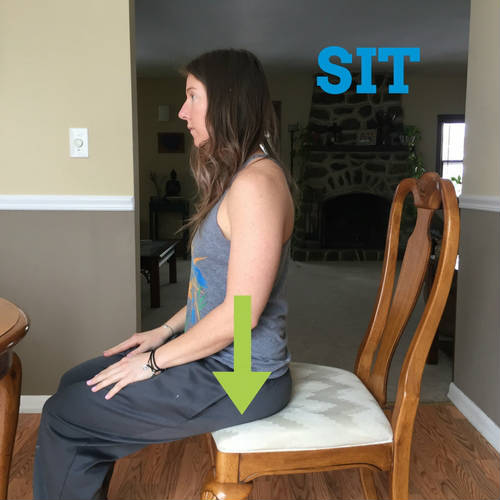
Slide: move your butt as far back on the chair it will go.
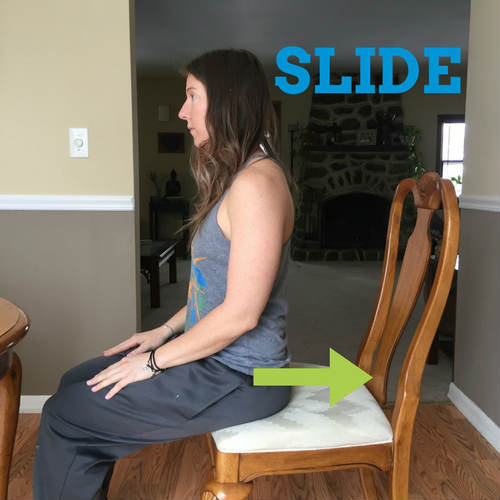
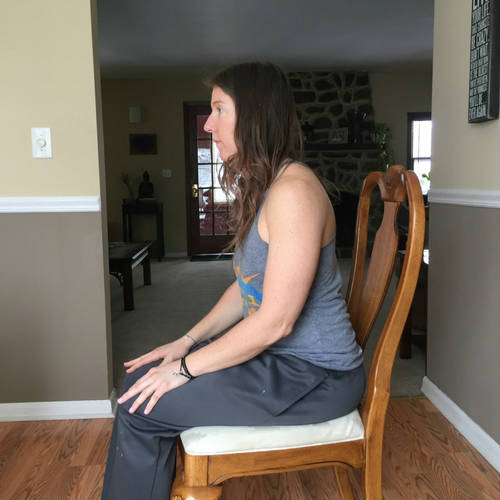
Lean: put your back on the chair back.
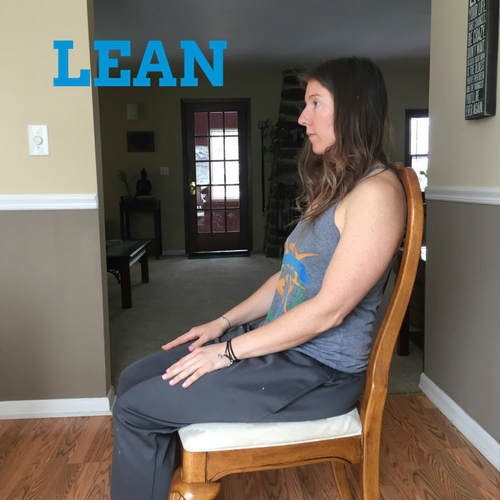
Simple to do, when conscious.
Hard because, you’re often unconscious.
It’s OK. I’m unconscious too. We all have permission to be human. The trick is to be mindful and aware.
It doesn’t hurt to put a post-it note on your computer screen that says “Sit, Slide, Lean” or to set an hourly reminder on your calendar or I-phone to check in on you.
A Brief Note on The Chair
At this time, I don’t have an opinion on a specific chair.
As a rule of thumb, the contour of the back of the chair should match the natural “S” curve of your low back. This balances load throughout the entirety of your spinal joints.
Notice the “S” curve of the spine in the standing pirate below.

Now, notice how the “S” curve of the spine in the sitting pirate below. It hasn’t changed. That’s the goal.
 ‘I do have an opinion that as many working postures as possible is best to move loads around the body while working.
‘I do have an opinion that as many working postures as possible is best to move loads around the body while working.
How many working postures can you count in the picture below? (It’s not a trick question.)
What Sitting Correctly Can Do For You
As a fix-your-pain practice in New Jersey and New York City, we see a lot of bad low back disc and cervical disc cases of desk warriors.
As a rule, we do not treat patients on the same day as the history, exam, and report of findings.
At times, there could be up to 7 days before we get an opportunity to do the first treatment.
We’ve experimented with giving the Sit, Slide, and Lean Rule to patients before their treatments.
Years of pain can go down 2-4 pain points on the pain scale by respecting this rule.
What does that look like?
Assume 0=no pain and 10=the worst pain in the world. Imagine a person has:
- 0/10 pain when he wakes up,
- 2/10 pain at lunch time,
- 4/10 pain at 3 PM, and
- 6/10 pain during the drive home.
I’ve seen the Sit, Slide, and Lean Rule change the growing pain, without any treatment, to:
- 0/10 pain when he wakes up,
- 0/10 pain at lunch time,
- 2/10 pain at 3 PM, and
- 4/10 pain during the drive home.
How did it change the pain? Imagine the slower trickle of the faucet causing the first spillage at 3 PM instead of lunch time.
If you have never had debilitating low back pain, this may not seem like a big deal. But for those of you reading this who have suffered for a long period of time with really intense pain, you know that:
Any relief is welcome.
Play with the Sit, Slide, and Lean Rule. Add working postures to your work environment like the pirates in the Barefoot Rehab office.
The Sit, Slide, Lean Rule was taught to me by Dr. William Brady of Integrative Diagnosis. If you want to find the highest quality pain doctor again, you can find a provider here.

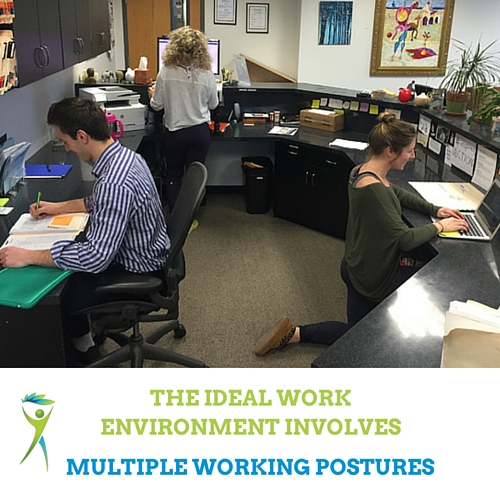

Top 5 Ways to Prevent Adhesion (In the Muscles) From Building Up (Or Coming Back)
Posted at 15:43h, 29 February[…] why the Sit-Slide-Lean Rule is so important if you value the longevity of your low back and neck and if you want to recover […]
Sunaofe Furniture
Posted at 07:53h, 19 SeptemberA workplace chair is the most typical chair style in the workplace. They may be rolled about and adjusted in height. All chairs in the office should include a mechanism that allows the user to alter the height of the seat to suit their needs. It’s also important that the backrest is at a reasonable height. Chairs in the workplace should not be placed on top of disorganized workstations or on uneven flooring.
You Should Check Out sunaofe.com Right Away
Dr. Chris
Posted at 17:56h, 21 SeptemberTY!
Kitty Russell
Posted at 01:03h, 20 SeptemberI just ran across your therapy today, and am interested to see if your ART might help my Husband, Billy. To start off; Billy has been very active growing up, with bull riding, car wrecks, and bar fights. (Typical Texas boy!) About 15 years ago, he had a cervical spine fusion of c-4, 5, and 6, due to nerve impingement. That procedure helped him a for a long time. For the last 2-3 years, Billy has been getting terrible headaches. He can feel them coming on, from the back of his head, near the occipital area; and travel around his head to the temples. What is really scary, is that the headache affects his speech and ability to swallow. He gets dizzy and blurred vision. I am retired from nursing and massage therapy, and have tried many things to help him. ( ice packs-with some help, heat packs-with no help, massage, mild traction, scalp massage, anti-inflamatory meds. Prescription meds like Tramadol, didn’t help. Recently, he’s been using Excedrine Migraine, with fair results. Because of the fusion, we are reluctant to try chiropractic. Billy is a long-haul truck driver, and a type “A” person. It’s terrible to see him in such pain! Especially when he is far from home. We are at the end of our rope; and really need help. He is an independent driver and does not have insurance. We live in Wyoming, with not a lot of medical resources available. The Denver or Salt Lake areas, might be options. Could you recommend anything? Getting desperate. Thank you, and God Bless.
Dr. Chris
Posted at 17:35h, 24 SeptemberHi Kitty, so sorry to hear this. First, you mentioned ART and chiropractic. We don’t do either of those and I wouldn’t recommend either for someone like your husband. Yes, it sounds like he can have a lot of adhesion or nerve entrapments (Greater or lesser occipital nerves). I recommend Avail Soft Tissue in Colorado. That’s closest to you.
Here is 1 video to inspire you:
https://www.youtube.com/watch?v=50p86R7cbB4